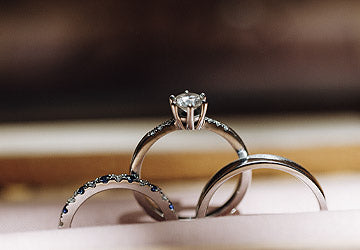If you’re curious about the beautiful gems shining up from the display case, you might be asking yourself, “where do gems come from?” The gemstones that end up on your ring, neck, or earrings are natural crystalline mineral structures that formed over many years deep in the earth. And, it might surprise you to learn that gems and rocks aren't all that different from each other.
Learn everything you want to know about how gemstones are formed inside the earth. Find out how the geological process creates the conditions for minerals to crystalize. And, discover how you can create your very own crystals to see the process in action – and to create a tasty snack.
WHERE DO GEMS COME FROM AND HOW DO THEY FORM?
If you are wondering “where do gems come from?” you have to look at the geology of gem formation. Gems come from specific crystal formations in There are five requirements for crystals to form: space, pressure, temperature, ingredients, and time.
And, from the formation of crystals, there are four ways in which gemstones can form, which coincides with the ways rocks are formed. Gems and rocks form when minerals combine in crystalline structures. The type of crystals that form depends on the type of rock it forms in.
THE 4 WAYS IN WHICH GEMS AND ROCKS FORM
Gems and rocks are made up of minerals, which bond together to form crystalline structures. But, depending on the conditions present, different types of gems can form in different environments. And, when it comes to gem creation, it all happens below your feet. The earth is like a huge convection oven, and it is constantly cooking up new rocks.
Here are the four different types of rocks and how they are formed:
- Igneous - The most valuable rocks form in the presence of extreme heat and pressure
- Hydrothermal - Come from the cooling of mineral-rich water reservoirs under the ocean floor.
- Metamorphic - Are created under extreme heat and pressure but come from the transfiguration of hydrothermal rocks.
- Sedimentary - Are the closest to your feet, even though they are still deep underground – they are formed by sediment in water convalescing over many years.
HOW DO MINERALS CRYSTALIZE?
Gems come from the crystallization of minerals, so how do minerals crystalize? You can see the process for yourself with an easy experiment in your kitchen. All you need is an empty jar, a pot of water, a stove, sugar, and a wood stick.
This is a simplified process of mineral crystallization as compared to what a gem goes through, but it demonstrates the point. As discussed above, crystallization requires time, space, ingredients, heat, and pressure. Your stove supplies the heat, the sugar and water provide your minerals, and the crystals will grow on the wood stick.
CRYSTALLIZATION OF SUGAR EXPERIMENT
Heat 3 cups of water with 1 cup of sugar to boiling, until the sugar melts. Stir it with a metal spoon and add an additional cup of sugar, string the mixture until the sugar melts. Once 2 cups of sugar are melted into the hot water, pour the contents of the pot into your jar and place your wood stick into the jar with the top sticking out. The longer it takes for your sugar to cool, the larger the crystals that will form.
In about a week, the excess sugar will form in crystal structures on your wooden stick, producing a delicious piece of rock candy. When you transfer this process to what is going on inside the earth, you get gemstones – instead of rock candy.
CRYSTALLIZATION OF MINERALS IN THE EARTH TO FORM GEMS
When looking at the crystallization of minerals in the earth, temperature means everything to the structure that occurs. Just like the crystallization of sugar in your experiment – inside the earth, different crystals for at different temperatures. Corundum, for example, forms in the still-hot solution, while topaz forms after it cools a bit – and quartz crystals form after the solution cools further still.
Sugar crystals form in extremely low-pressure environments, which makes it a perfect experiment for you to perform on the earth's surface. Gems, however, do not form in low-pressure environments like that of sugar crystals. For gems to form, there must be considerable pressure and heat over a long time, which is present in the earth's mantle.
Geologists and gemologists can recreate the natural conditions necessary for crystallization with the help of modern technology and industrial laboratory resources. But, nothing compares to the gems forged in the tumultuous conditions underneath the earth's crust. And when it comes to jewelry, there is no substitute for earth-mined natural gems.
If you want to learn more regarding where do gems come from, talk with a professional jeweler, today to see some examples of beautiful earth-mined gems.





